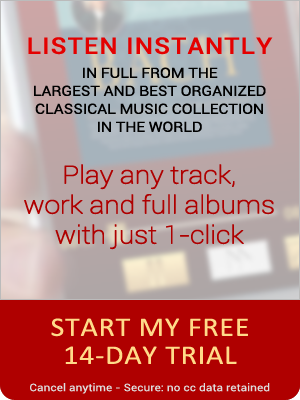period: Contemporary
 The expression “contemporary music” is generic to an extreme – meaning simply music written “today”, but has become commonplace to denote art music written since World War II, or more generally music written by composers living in our time. Broadly speaking, a division can be made between the reigning aesthetic before and after around 1970, although the entire period constitutes perhaps the most eclectic and “pluralistic” in music history. From 1945 through the late-1960s, a rejuvenated and rather austere application of Modernism was instituted under the influence of music theorists such as Adorno, who saw Arnold Schoenberg’s serial or 12-tone technique as the true path toward progress – dismissing as false prophets composers such as Igor Stravinsky and Béla Bartòk who maintained some allegiance to tonality. The young, post-War generation of composers, led by Pierre Boulez, Karlheinz Stockhausen, György Ligeti, Luciano Berio, Elliott Carter, and others, adopted especially Anton Webern’s abstract and pointillist language as a point of departure, and seemed to relish in the growing schism between composer and public, finding sanctuary in academia, as well as at modern music festivals at Darmstadt, Cologne, Paris, and elsewhere. New technology, especially via computers, was readily integrated into the progressive agenda, spawning the rise of electronic music, by composers such as Edgard Varèse, Luigi Nono, and Milton Babbitt – in turn further alienating traditional concert audiences.
The expression “contemporary music” is generic to an extreme – meaning simply music written “today”, but has become commonplace to denote art music written since World War II, or more generally music written by composers living in our time. Broadly speaking, a division can be made between the reigning aesthetic before and after around 1970, although the entire period constitutes perhaps the most eclectic and “pluralistic” in music history. From 1945 through the late-1960s, a rejuvenated and rather austere application of Modernism was instituted under the influence of music theorists such as Adorno, who saw Arnold Schoenberg’s serial or 12-tone technique as the true path toward progress – dismissing as false prophets composers such as Igor Stravinsky and Béla Bartòk who maintained some allegiance to tonality. The young, post-War generation of composers, led by Pierre Boulez, Karlheinz Stockhausen, György Ligeti, Luciano Berio, Elliott Carter, and others, adopted especially Anton Webern’s abstract and pointillist language as a point of departure, and seemed to relish in the growing schism between composer and public, finding sanctuary in academia, as well as at modern music festivals at Darmstadt, Cologne, Paris, and elsewhere. New technology, especially via computers, was readily integrated into the progressive agenda, spawning the rise of electronic music, by composers such as Edgard Varèse, Luigi Nono, and Milton Babbitt – in turn further alienating traditional concert audiences.
From the mid-1970s, an opposing anti- or post-modernist aesthetic began to emerge, where modernist assumptions were questioned if not rejected. Eccentric thinkers such John Cage promoted a free approach to composition, with an openness to adopt any technique or aesthetic, including the possibilities of chance. An unprecedented eclecticism or pluralism arose among composers in Europe and America – where rock, pop, non-Western, modernist, or historical classical styles could be easily incorporated without claiming any one perspective as more legitimate than the other. Composers adopting a Minimalist approach – such as Philip Glass, Steve Reich, Terry Riley, and John Adams – more directly challenged the modernist tendencies via a highly diatonic and deliberately repetitive, non-linear approach. A return to diatonic, accessible music, moreover, was derived not only from a desire to regain connection with larger audiences, but also as an expression of a new internationalism, spirituality, or mysticism – as in the works of Arvo Pärt, Lou Harrison, and Toru Takemitsu. Multiculturalism, “otherness”, and progressive views of race, class, and gender, are all aesthetic options for composers in today’s world, as are more “traditional” approaches of modernism and the incorporation of historical musical styles. Indeed, this is a truly fascinating time for composers and audiences alike!

Nolan Gasser, PhD
Artistic Director
















